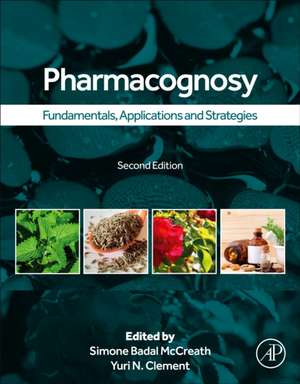Pharmacognosy: Fundamentals, Applications, and Strategies
Editat de Simone Badal McCreath, Yuri N. Clementen Limba Engleză Paperback – 18 oct 2023
Structured in seven parts, the book covers the foundational aspects of Pharmacognosy, the chemistry of plant metabolites, their effects, other sources of metabolites, crude drugs from animals, basic animal anatomy and physiology, technological applications and biotechnology, and the current trends in research. New to this edition is a chapter on plant metabolites and SARS-Cov-2, extensive updates on existing chapters and the development of a Laboratory Guide to support instructors execute practical activities on the laboratory setting.
- Covers the main sources of natural bioactive substances
- Contains practice questions and laboratory exercises at the end of every chapter to test learning and retention
- Describes how pharmacokinetics and pharmacodynamics play a crucial role in discerning the relationships of active metabolites to bioavailability and function at active sites
- Includes a dedicated chapter on the effect of plant metabolites on SARS-CoV-2
Preț: 733.68 lei
Preț vechi: 898.15 lei
-18% Nou
Puncte Express: 1101
Preț estimativ în valută:
140.39€ • 146.58$ • 116.19£
140.39€ • 146.58$ • 116.19£
Carte tipărită la comandă
Livrare economică 29 martie-12 aprilie
Livrare express 01-07 martie pentru 225.38 lei
Preluare comenzi: 021 569.72.76
Specificații
ISBN-13: 9780443186578
ISBN-10: 044318657X
Pagini: 846
Dimensiuni: 216 x 276 x 47 mm
Greutate: 2.18 kg
Ediția:2
Editura: ELSEVIER SCIENCE
ISBN-10: 044318657X
Pagini: 846
Dimensiuni: 216 x 276 x 47 mm
Greutate: 2.18 kg
Ediția:2
Editura: ELSEVIER SCIENCE
Public țintă
Student of pharmacology, and pharmaceutical sciences.Professionals in natural products in pharma and cosmetics industry.
Cuprins
Section 1: Pharmacognosy 101
1. Background to pharmacognosy
2. Traditional medicine
3. Plant anatomy and physiology
4. Plant constituents: carbohydrates, oils, resins, balsams, and plant hormones
5. Plant crude drugs
Section 2: Plant metabolites: their chemistry
6. Evolutionary perspectives on the role of plant secondary metabolites
7. Glycosides
8. Alkaloids
9. Tannins
10. Terpenoids
11. Other plant metabolites
12. Vitamins
Section 3: Plant metabolites: their effects
13. Chemotherapeutics
14. Bioactive plant molecules, sources, and mechanisms of action in the treatment of cardiovascular diseases
15. Plant metabolites for treating diseases
16. Psychoactive drugs
Section 4: Metabolites from other sources
17. Marine metabolites: oceans of opportunity
18. Animal metabolites: from amphibians, reptiles, Aves/birds, and invertebrates
19. Fungal metabolites: a focus on endophytes
Section 5: Crude drugs from animals
20. Fats
21. Waxes
Section 6: Basic animal anatomy and physiology
22. Basic animal anatomy and physiology
23. Proteins
24. Pharmacokinetics
25. Pharmacodynamics— a pharmacognosy perspective
26. Drug metabolism
Section 7: Technological applications using biological systems
27. Biotechnology: principles and applications
Section 8 Current trends in pharmacognosy research
28. Nuclear magnetic resonance spectroscopy in drug discovery
29. Metabolomics approach in pharmacognosy
30. Novel targets in drug discovery
31. Nanotechnology: creating, manipulating, and observing nanostructured systems in biology and medicine
32. Ethical aspects of working with local communities and their biological resources
33. Factors to consider in development of nutraceutical and dietary supplements
34. The global regulatory framework for medicinal plants
1. Background to pharmacognosy
2. Traditional medicine
3. Plant anatomy and physiology
4. Plant constituents: carbohydrates, oils, resins, balsams, and plant hormones
5. Plant crude drugs
Section 2: Plant metabolites: their chemistry
6. Evolutionary perspectives on the role of plant secondary metabolites
7. Glycosides
8. Alkaloids
9. Tannins
10. Terpenoids
11. Other plant metabolites
12. Vitamins
Section 3: Plant metabolites: their effects
13. Chemotherapeutics
14. Bioactive plant molecules, sources, and mechanisms of action in the treatment of cardiovascular diseases
15. Plant metabolites for treating diseases
16. Psychoactive drugs
Section 4: Metabolites from other sources
17. Marine metabolites: oceans of opportunity
18. Animal metabolites: from amphibians, reptiles, Aves/birds, and invertebrates
19. Fungal metabolites: a focus on endophytes
Section 5: Crude drugs from animals
20. Fats
21. Waxes
Section 6: Basic animal anatomy and physiology
22. Basic animal anatomy and physiology
23. Proteins
24. Pharmacokinetics
25. Pharmacodynamics— a pharmacognosy perspective
26. Drug metabolism
Section 7: Technological applications using biological systems
27. Biotechnology: principles and applications
Section 8 Current trends in pharmacognosy research
28. Nuclear magnetic resonance spectroscopy in drug discovery
29. Metabolomics approach in pharmacognosy
30. Novel targets in drug discovery
31. Nanotechnology: creating, manipulating, and observing nanostructured systems in biology and medicine
32. Ethical aspects of working with local communities and their biological resources
33. Factors to consider in development of nutraceutical and dietary supplements
34. The global regulatory framework for medicinal plants
